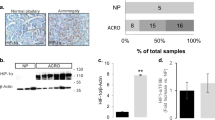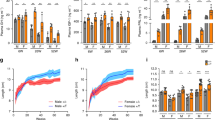Abstract
ONE or more of three Gi proteins, Gi1–3, mediates hormonal inhibition of adenylyl cyclase1–3. Whether this inhibition is mediated by the α or by the βγ subunits of Gi proteins is unclear1,2. Mutations inhibiting the intrinsic GTPase activity of another G protein, the stimulatory regulator of adenylyl cyclase (Gs), con-stitutively activate it by replacing either of two conserved amino acids in its α subunit (αs)4–7. These mutations create the gsp oncogene which is found in human pituitary and thyroid tumours5,8. In a second group of human endocrine tumours, somatic mutations in the a subunit of Gi2 replace a residue cognate to one of those affected by gsp mutations8. This implies that the mutations convert the αi2 gene into a dominantly acting oncogene, called gip2 (ref. 8), and that the mutant αi2 subunits are constitutively active. We have therefore assessed cyclic AMP accumulation in cultured cells which stably or transiently express exogenous wild-type αi2 complementary DNA or either of two mutant αi2 cDNAs. The results show that putatively oncogenic mutations in αi2 constitutively activate the protein's ability to inhibit cAMP accumulation.
This is a preview of subscription content, access via your institution
Access options
Subscribe to this journal
Receive 51 print issues and online access
$199.00 per year
only $3.90 per issue
Buy this article
- Purchase on Springer Link
- Instant access to full article PDF
Prices may be subject to local taxes which are calculated during checkout
Similar content being viewed by others
References
Freissmuth, M., Casey, P. J. & Gilman, A. G. FASEB J. 3, 2125–2131 (1989).
Birnbaumer, L. A. Rev. Pharmac. Tox. 30, 675–705 (1990).
Bourne, H. R., Sanders, D. A. & McCormick, F. Nature 348, 125–132 (1990).
Masters, S. B. et al. J. biol. Chem. 264, 15467–15474 (1989).
Landis, C. A. et al. Nature 340, 692–696 (1989).
Graziano, M. P. & Gilman, A. G. J. biol. Chem. 264, 15475–15482 (1989).
Freissmuth, M. & Gilman, A. G. J. biol. Chem. 264, 21907–21914 (1989).
Lyons, J. et al. Science 249, 655–659 (1990).
Seamon, K. & Daly, J. W. J. biol. Chem. 257, 9799–9801 (1981).
Murayama, T. & Ui, M. J. biol. Chem. 262, 5522–5529 (1987).
van Corven, E. J., Groenink, A., Jalink, K., Eichholtz, T. & Moolenaar, W. H. Cell 59, 45–54 (1989).
Zachary, I., Masters, S. B. & Bourne, H. R. Biochem. biophys. Res. Commun. 168, 1184–1193 (1990).
McFarland, K. C. et al. Science 245, 494–499 (1989).
Guyer, C. A. et al. J. biol. Chem. 265, 17307–17317 (1990).
Price, S. R., Barber, A. & Moss, J. in ADP-ribosylating Toxins and G Proteins. Insights into Signal Transduction (eds Moss, J. & Vaughan, M.) 397–424 (Am. Soc. Microbiology, Washington, DC, 1990).
Katada, T., Oinuma, M. & Ui, M. J. biol. Chem. 261, 5215–5221 (1986).
Gilman, A. G. A. Rev. Biochem. 56, 615–649 (1987).
Katada, T., Northup, J. K., Bokoch, G. M., Ui, M. & Gilman, A. G. J. biol. Chem. 259, 3578–3585 (1984).
Hildebrandt, J. D., Codina, J. & Birnbaumer, L. J. biol. Chem. 259, 13178–13185 (1984).
Kobayashi, I. et al. Eur. J. Biochem. 191, 499–506 (1990).
Hildebrandt, J. D., Hanoune, J. & Birnbaumer, L. J. biol. Chem. 257, 14723–14725 (1982).
Hildebrandt, J. D. et al. Nature 302, 706–709 (1983).
Jakobs, K. H., Aktories, K. & Schultz, G. Nature 303, 177–178 (1983).
Jakobs, K. H. & Schultz, G. Proc. natn. Acad. Sci. U.S.A. 80, 3899–3902 (1983).
Katada, T., Bockoch, G. M., Smigel, M. D., Ui, M. & Gilman, A. G. J. biol. Chem. 259, 3586–3595 (1984).
Sullivan, K. A., et al. Proc. natn. Acad. Sci. U.S.A. 83, 6687–6691 (1986).
Sullivan, K. A., et al. Nature 330, 758–760 (1987).
Salomon, Y., Londos, C. & Rodbell, M. Analyt. Biochem. 58, 541–548 (1974).
Evans, T., Fawzi, A., Fraser, E. D., Brown, M. L. & Northup, J. K. J. biol. Chem. 262, 176–181 (1987).
Chang, F.-H. & Bourne, H. R. Endocrinology 121, 1711–1715 (1987).
Author information
Authors and Affiliations
Rights and permissions
About this article
Cite this article
Wong, Y., Federman, A., Pace, A. et al. Mutant α subunits of Gi2 inhibit cyclic AMP accumulation. Nature 351, 63–65 (1991). https://doi.org/10.1038/351063a0
Received:
Accepted:
Issue Date:
DOI: https://doi.org/10.1038/351063a0
This article is cited by
-
MiR-30c-5p-Targeted Regulation of GNAI2 Improves Neural Function Injury and Inflammation in Cerebral Ischemia-Reperfusion Injury
Applied Biochemistry and Biotechnology (2023)
-
The TRPM1 channel in ON-bipolar cells is gated by both the α and the βγ subunits of the G-protein Go
Scientific Reports (2016)
-
Regulator of G protein signalling 14 attenuates cardiac remodelling through the MEK–ERK1/2 signalling pathway
Basic Research in Cardiology (2016)
-
Activator of G protein signaling 3 forms a complex with resistance to inhibitors of cholinesterase-8A without promoting nucleotide exchange on Gαi3
Molecular and Cellular Biochemistry (2015)
-
Suppression of GNAI2 message in ovarian cancer
Journal of Ovarian Research (2014)
Comments
By submitting a comment you agree to abide by our Terms and Community Guidelines. If you find something abusive or that does not comply with our terms or guidelines please flag it as inappropriate.



